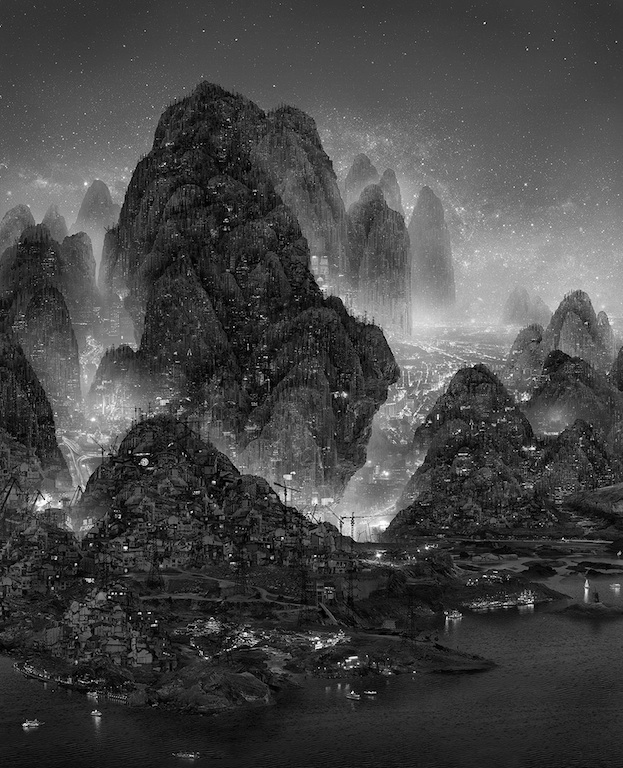
Yang Yongliang, Wintery Forest in the Night from the series Artificial Wonderland II, 2014
The extraordinary pace of economic and urban growth in China is watched with awe around the world, and Chinese artists and photographers are at the forefront of monitoring and interpreting these changes. Sluggish cultural traditions may have needed renewal, but the price of rapid development, and the mass relocation from the land to newly built cities, is the eradication of ways of life that go back centuries.
The Shanghai artist Yang Yongliang’s huge picture, nearly six feet high, glitters with a premonition of beauty and terror. Its mountains look like those in traditional Chinese shan shui (landscape) paintings, but the phosphorescence is unearthly as though the towering rock formations are swathed in a vast energy field of extraterrestrial origin. Light flows between the pinnacles like electrical lava. Even before the true nature of these peaks and rock faces becomes clear, the cranes along the lower ridge indicate a landscape that is continuously under construction and unstable, rising into the luminous night sky like the outcrops of an unimaginably powerful subterranean reaction.
Seen close up, the terrain proves to be a digital montage of daunting complexity composed of hundreds of fragmentary images of buildings blended with shots of mountain rocks taken by Yongliang in Iceland and Norway—see these larger details. Highways and cars occupy the rivers of light, and even people can be observed. The slopes at the base are built from a crushed heap of old dilapidated structures, which represent the indiscriminate clearance that hasty new development often entails.
Yongliang has closely modeled the montage, titled Wintery Forest in the Night (2014), on Snow in Winter Woods, a painting on silk in the Tianjin Museum once ascribed to the Song Dynasty (960-1279) master Fan Kuan, though scholars have questioned this attribution. Shan shui paintings feature water and mountains, which were regarded as sacred places because of their proximity to the heavens. An image of this kind is not a literal rendition of what the artist sees in nature, but a mental image of harmony. By co-opting traditional paintings that are familiar icons to Chinese viewers, Yongliang fashions topical commentaries of great potency. The artificial environment fabricated by humans consumes the landscape and replaces it with a simulacrum, yet the shimmering immensity of the technosphere has its own wonder and exhilaration. It can even seem sublime. Yongliang has worked in this vein for the past decade, devising ever more grandiose visions, like glimpses from science fiction of an ambivalent future-world to which the next generation must somehow adapt.
See all Exposure columns


Comments [2]
03.02.16
06:35
03.07.16
01:51